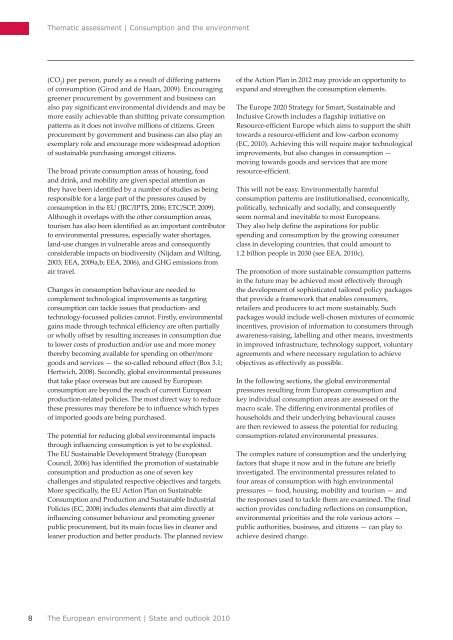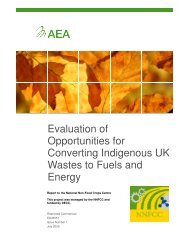Consumption and the environment (SOER2010) - European ...
Consumption and the environment (SOER2010) - European ...
Consumption and the environment (SOER2010) - European ...
Create successful ePaper yourself
Turn your PDF publications into a flip-book with our unique Google optimized e-Paper software.
Thematic assessment | <strong>Consumption</strong> <strong>and</strong> <strong>the</strong> <strong>environment</strong><br />
(CO 2<br />
) per person, purely as a result of differing patterns<br />
of consumption (Girod <strong>and</strong> de Haan, 2009). Encouraging<br />
greener procurement by government <strong>and</strong> business can<br />
also pay significant <strong>environment</strong>al dividends <strong>and</strong> may be<br />
more easily achievable than shifting private consumption<br />
patterns as it does not involve millions of citizens. Green<br />
procurement by government <strong>and</strong> business can also play an<br />
exemplary role <strong>and</strong> encourage more widespread adoption<br />
of sustainable purchasing amongst citizens.<br />
The broad private consumption areas of housing, food<br />
<strong>and</strong> drink, <strong>and</strong> mobility are given special attention as<br />
<strong>the</strong>y have been identified by a number of studies as being<br />
responsible for a large part of <strong>the</strong> pressures caused by<br />
consumption in <strong>the</strong> EU (JRC/IPTS, 2006; ETC/SCP, 2009).<br />
Although it overlaps with <strong>the</strong> o<strong>the</strong>r consumption areas,<br />
tourism has also been identified as an important contributor<br />
to <strong>environment</strong>al pressures, especially water shortages,<br />
l<strong>and</strong>-use changes in vulnerable areas <strong>and</strong> consequently<br />
considerable impacts on biodiversity (Nijdam <strong>and</strong> Wilting,<br />
2003; EEA, 2009a,b; EEA, 2006), <strong>and</strong> GHG emissions from<br />
air travel.<br />
Changes in consumption behaviour are needed to<br />
complement technological improvements as targeting<br />
consumption can tackle issues that production- <strong>and</strong><br />
technology-focussed policies cannot. Firstly, <strong>environment</strong>al<br />
gains made through technical efficiency are often partially<br />
or wholly offset by resulting increases in consumption due<br />
to lower costs of production <strong>and</strong>/or use <strong>and</strong> more money<br />
<strong>the</strong>reby becoming available for spending on o<strong>the</strong>r/more<br />
goods <strong>and</strong> services — <strong>the</strong> so‐called rebound effect (Box 3.1;<br />
Hertwich, 2008). Secondly, global <strong>environment</strong>al pressures<br />
that take place overseas but are caused by <strong>European</strong><br />
consumption are beyond <strong>the</strong> reach of current <strong>European</strong><br />
production-related policies. The most direct way to reduce<br />
<strong>the</strong>se pressures may <strong>the</strong>refore be to influence which types<br />
of imported goods are being purchased.<br />
The potential for reducing global <strong>environment</strong>al impacts<br />
through influencing consumption is yet to be exploited.<br />
The EU Sustainable Development Strategy (<strong>European</strong><br />
Council, 2006) has identified <strong>the</strong> promotion of sustainable<br />
consumption <strong>and</strong> production as one of seven key<br />
challenges <strong>and</strong> stipulated respective objectives <strong>and</strong> targets.<br />
More specifically, <strong>the</strong> EU Action Plan on Sustainable<br />
<strong>Consumption</strong> <strong>and</strong> Production <strong>and</strong> Sustainable Industrial<br />
Policies (EC, 2008) includes elements that aim directly at<br />
influencing consumer behaviour <strong>and</strong> promoting greener<br />
public procurement, but its main focus lies in cleaner <strong>and</strong><br />
leaner production <strong>and</strong> better products. The planned review<br />
of <strong>the</strong> Action Plan in 2012 may provide an opportunity to<br />
exp<strong>and</strong> <strong>and</strong> streng<strong>the</strong>n <strong>the</strong> consumption elements.<br />
The Europe 2020 Strategy for Smart, Sustainable <strong>and</strong><br />
Inclusive Growth includes a flagship initiative on<br />
Resource-efficient Europe which aims to support <strong>the</strong> shift<br />
towards a resource-efficient <strong>and</strong> low-carbon economy<br />
(EC, 2010). Achieving this will require major technological<br />
improvements, but also changes in consumption —<br />
moving towards goods <strong>and</strong> services that are more<br />
resource-efficient.<br />
This will not be easy. Environmentally harmful<br />
consumption patterns are institutionalised, economically,<br />
politically, technically <strong>and</strong> socially, <strong>and</strong> consequently<br />
seem normal <strong>and</strong> inevitable to most <strong>European</strong>s.<br />
They also help define <strong>the</strong> aspirations for public<br />
spending <strong>and</strong> consumption by <strong>the</strong> growing consumer<br />
class in developing countries, that could amount to<br />
1.2 billion people in 2030 (see EEA, 2010c).<br />
The promotion of more sustainable consumption patterns<br />
in <strong>the</strong> future may be achieved most effectively through<br />
<strong>the</strong> development of sophisticated tailored policy packages<br />
that provide a framework that enables consumers,<br />
retailers <strong>and</strong> producers to act more sustainably. Such<br />
packages would include well-chosen mixtures of economic<br />
incentives, provision of information to consumers through<br />
awareness-raising, labelling <strong>and</strong> o<strong>the</strong>r means, investments<br />
in improved infrastructure, technology support, voluntary<br />
agreements <strong>and</strong> where necessary regulation to achieve<br />
objectives as effectively as possible.<br />
In <strong>the</strong> following sections, <strong>the</strong> global <strong>environment</strong>al<br />
pressures resulting from <strong>European</strong> consumption <strong>and</strong><br />
key individual consumption areas are assessed on <strong>the</strong><br />
macro scale. The differing <strong>environment</strong>al profiles of<br />
households <strong>and</strong> <strong>the</strong>ir underlying behavioural causes<br />
are <strong>the</strong>n reviewed to assess <strong>the</strong> potential for reducing<br />
consumption-related <strong>environment</strong>al pressures.<br />
The complex nature of consumption <strong>and</strong> <strong>the</strong> underlying<br />
factors that shape it now <strong>and</strong> in <strong>the</strong> future are briefly<br />
investigated. The <strong>environment</strong>al pressures related to<br />
four areas of consumption with high <strong>environment</strong>al<br />
pressures — food, housing, mobility <strong>and</strong> tourism — <strong>and</strong><br />
<strong>the</strong> responses used to tackle <strong>the</strong>m are examined. The final<br />
section provides concluding reflections on consumption,<br />
<strong>environment</strong>al priorities <strong>and</strong> <strong>the</strong> role various actors —<br />
public authorities, business, <strong>and</strong> citizens — can play to<br />
achieve desired change.<br />
8<br />
The <strong>European</strong> <strong>environment</strong> | State <strong>and</strong> outlook 2010








